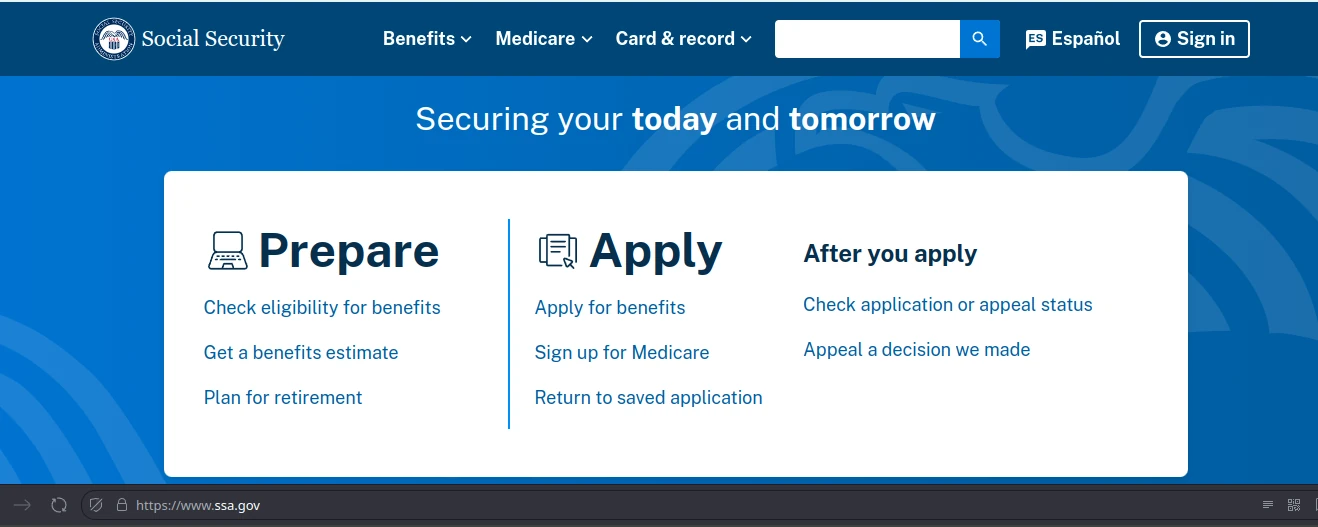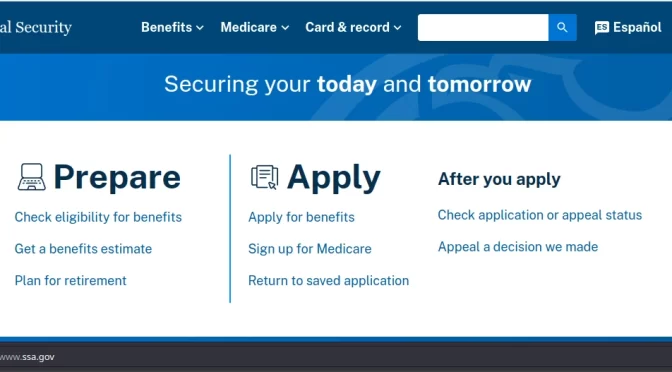DURING Biden Admin, an audit concluded Aug. 2024:
- 2015 – 2022 = $74Bn OVERPAYMENT
- End of 2023 = $23Bn Uncollected
- Create an ONLINE account or go in person for verification
- Existing people will continue to receive benefits
- ONLY if you are applying for benefits, changing direct deposit or new application
- See below for ID types

Create an account here:
“Through several audits, Social Security Administration’s Office of the Inspector General made dozens of recommendations for the Agency to prevent improper payments before they occur as well as to detect and correct existing improper payments. However, to date, many of those recommendations remain unimplemented, leading to continued improper payments.
The report Preventing, Detecting, and Recovering Improper Payments summarizes OIG’s audit work regarding improper payments, which OIG identified as a major management challenge since Fiscal Year (FY) 2002. Improper payments can be overpayments (when SSA pays someone more than they are due) or underpayments (when SSA pays someone less than they are due).
From FYs 2015 through 2022, SSA estimates it made nearly $72 billion in improper payments, most of which were overpayments. While this is less than 1 percent of the total benefits paid during that period, at the end of FY 2023, SSA had an uncollected overpayment balance of $23 billion.
Most of the unimplemented recommendations addressed two reasons for improper payments in SSA’s programs: beneficiary self reporting information and insufficient controls in SSA’s automated and manual processes. OIG’s audits confirmed SSA’s reliance on beneficiaries to self report changes in their circumstances resulted in improper payments. Obtaining data that assist with making eligibility and payment determinations from external sources, such as other Federal and state agencies and financial institutions, is critical to preventing and detecting improper payments.
SSA also has not implemented a number of recommendations related to its processes to recover overpayments and issue underpayments. OIG’s audits found the Agency’s actions to process over and underpayments were not always effective or consistent. SSA anticipated a new debt management product would address many of the recommendations. However, the Agency stopped implementation efforts in FY 2024 because the new product was not funded.
“Improper payments have been a longstanding challenge for SSA. While the Agency has taken actions to address this challenge, it needs to do more, and OIG’s recommendations can guide the Agency as it determines those corrective actions,” said Michelle L. Anderson, Assistant Inspector General for Audit and Acting Inspector General. “Without better access to data, increased automation, systems modernization, and policy or legislative changes, improper payments will continue to be a major challenge for SSA into the future.”
SSA has taken some steps to improve the prevention, detection, and recovery of improper payments. For example, in October 2023, SSA initiated a comprehensive review of overpayment procedures, policies, systems, and communications to determine where it could make improvements. SSA is also developing an information exchange to obtain monthly earnings data from third-party payroll data providers, which may reduce the occurrence of improper payments for beneficiaries who work while receiving benefits. See the full report here. “ Office of the General Inspector, ssa.gov, 03-31-2025
COMBAT FRAUD
“Aimed to combat fraud, Social Security is strengthening the process to prove identity related to direct deposit information. This applies to individuals who need to provide initial direct deposit information when applying for certain cash benefits and to someone already receiving benefits if they choose to later change their direct deposit information on our records. The easiest and most secure way is online with a personal my Social Security account.
The public does not need to contact Social Security unless they need to change direct deposit information and cannot do it online. People will continue to receive their benefits and on schedule to the bank account information in Social Security’s records without needing to prove identity.
If applying for benefits or changing direct deposit information for existing benefits, the secure and most convenient way to prove identity is with Social Security’s online services using a personal my Social Security account.
If unable to use Social Security’s online services, a person
- Applying for Medicare or Social Security Disability Insurance or Supplemental Security Income does not need to visit a Social Security office to prove their identity. They can prove their identity by telephone.
- Applying for Retirement, Survivors, or Auxiliary (Spouse or Child) benefits must visit a Social Security office to prove their identity.
- Changing direct deposit information for any type of benefit must prove their identity in a Social Security office.
- Receiving payment by paper check must visit a Social Security office before changing their mailing address. “ ssa.gov, 03-31-2025
What ID Will Be Required?
With new voting rules in place, one question looms large: What ID will be required to prove citizenship and cast your ballot? The Social Security Administration (SSA) has clear standards, and they’re strict—only certain documents will cut it. Here’s everything you need to know about what works, what doesn’t, and how to prepare.
The Standards: What Makes an ID Valid?
According to the SSA, documents are acceptable as proof of identity only if they meet specific criteria:
- They “meet the stated primary, secondary, and third level evidence requirements (for example—unexpired, issued within the time frame stated)”.
- They are “originals (such as U.S. state issued driver’s licenses, state issued IDs and U.S. passports)”.
- They are “properly certified by the issuing agency (such as school records or medical records)”.
No copies, no expired IDs, no shortcuts—only originals or certified documents will do. So, what’s on the list?
Primary IDs: Your First Line of Proof
If you’ve got one of these, you’re set—these are the top-tier options:
- Unexpired U.S. driver’s license
- Unexpired state-issued non-driver ID card
- Unexpired U.S. passport or passport card
- Form I-551 (permanent resident card)
- Form I-94 with unexpired foreign passport
- Form I-766 (employment authorization document)
- Form I-872 (American Indian card, Texas Band of Kickapoos only)
These are the gold standard—unexpired, government-issued, and widely recognized. Most voters will likely lean on a driver’s license or passport.
Secondary IDs: Backup Options That Work
No primary ID? Don’t panic—the SSA accepts these secondary documents if they show your identity and citizenship:
- U.S. military ID (active duty, retiree, National Guard, or dependent)
- Certificate of Naturalization, or U.S. Citizenship
- Government or non-government employee ID showing name and photo or date of birth
- Certified medical record showing name and DOB
- Health insurance or Medicaid card with name and either photo, age, or DOB (not Medicare cards)
- School ID, transcript, or certified school record with identifying details
- Life insurance policy listing name and DOB
- Religious or tribal documents that meet SSA standards
These options broaden the net, but they still need to be current and certified where required. Note: Medicare cards don’t count—don’t try it.
Why It Matters Now
With voting rules tightening—like the recent executive order requiring proof of citizenship—these SSA standards could shape who gets to vote. Got an unexpired passport? You’re golden. Stuck with an old school record? Make sure it’s certified. The clock’s ticking to sort this out before Election Day.
Where to Check the Details
Still unsure? The SSA lays it all out at their official site: https://www.ssa.gov/news/identity-proofing.html. That’s your go-to for the fine print.
Sources
- SSA Identity Proofing Standards: All details and quoted criteria—e.g., “meet the stated primary, secondary, and third level evidence requirements (for example—unexpired, issued within the time frame stated)”—are sourced directly from the SSA at https://www.ssa.gov/news/identity-proofing.html, as provided in the original text.
- Social Security Administration http://www.ssa.gov/
- Office of the Inspector General, https://www.oig.ca.gov
- Preventing, Detecting, and Recovering Improper Payments https://oig.ssa.gov/assets/uploads/072401.pdf
Author, Ryan Bridglal, 03-31-2025
#featured #bridgenewzcom #bridgenewz #breakingnews #breaking #news #trump #donaldtrump #socialsecurity #ssa #finance #loss #revenue #debt #restructure #policy #musk #doge
